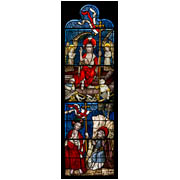Details
- Object type
stained glass window
- Title
Life of Jesus Christ and the Virgin Mary
- Place Associated
Germany, Boppard on Rhine, Carmelite Church (place associated); Germany, Rhine Region (place of manufacture); Jesse Tree Window (place of use)
- Date
circa 1444
- Materials
clear, coloured, stained and painted glass, lead, silver stain
- Dimensions
overall: 2600 mm x 2300 mm x 10 mm (approx.)
- Description
-
These panels once formed part of much larger window commissioned for the Carmelite Church of Boppard-am-Rhein, Germany. Some panels from this arrangement are now lost, although others can be found in the Metropolitan Museum of Art, New York, the Detroit Institute of Arts, and Salve Regina University, Rhode Island.
The Carmelite Church and former monastery at Boppard was under construction in 1320 and extended with a new north nave which was consecrated in 1444. This window was one of seven monumental windows made for the extension between 1440-1446. This particular window is dated to 1444 by the inclusion of a dated inscription on the associated panel in Detriot.
An original layout for the window was suggested by Jane Hayward, Associate Curator at The Metropolitan Museum, in her 1969 article, ‘Stained-Glass Windows from the Carmelite Church at Boppard-am-Rhein’. In her reconstruction, Hayward places these panels in the lower register, above the sleeping figure of Jesse, father of the biblical King David and an ancestor of Christ. The three panels representing the recumbent Jesse are thought to have been destroyed by fire in 1957. Below the prophet, at the foot of the composition, may have been three donor panels, of which the Burrell Collection retains one, possibly depicting Siegfried Von Gelnhausen and his Wife (45.489.2). The other two are also now lost.
'Tree of Jesse' windows commonly represent the ancestry of Christ in the form of a family tree, with branches emanating from Jesse, reaching upwards and supporting an array of biblical prophets and kings, culminating in the figures of the Virgin Mary and Christ (see 45.393-45.394). In Germany during the 13th-15th centuries, this genealogy was sometimes replaced with important scenes from the Life of Christ and his mother, the Virgin Mary.
In the Boppard arrangement, the central panels are dedicated to scenes from the Life of the Virgin, while the outer panels represent Christ’s Passion and triumphant Resurrection. This arrangement emphasises the Virgin’s central importance as the mother of Christ, and her particular significance to the Carmelites, to whom she was regarded as a patroness and the focus of ardent veneration. The iconography implies the Virgin’s own Immaculate Conception, a concept which, in the years preceding the erection of this glazing, had been vigorously defended by Carmelite representatives at the Council of Basel (1439).
Prior to the window's removal in 1818, Boppard had endured two decades of French occupation (1794-1814), during which time the church was secularised and responsibility for its upkeep handed over to the town of Boppard. Greatly impoverished by the events of recent years, the town could afford neither the maintenance nor repair the windows. A contemporary, Wilhelm Schlad, recalls their woeful condition in later writings “the wind blew terribly through the church through the gaps and missing sections… but all that was left was beautiful”. Subsequently the windows were removed and replaced with plain glazing by the aristocrat, Count Hermann Von Pückler, for an insubstantial sum. Pückler died in 1871 with his ambitious plans to install the windows in his family chapel at Muskau unrealised. Pückler’s heir sent many of the panels, still crated, to Berlin for restoration, later selling them to the Parisian dealer Friedrich Spitzer, from where they were widely dispersed by auction after his death in 1893.
Burrell acquired this window, alongside other Boppard glass (45.487), from William Randolph Hearst in 1938-1939. Panels from a further window (45.489), were acquired in 1939 from Robert Goelet. Too large for inclusion in Burrell’s domestic glazing scheme at Hutton Castle, he may have only viewed these panels on very rare occasions.
- Credit Line/Donor
Gifted by Sir William and Lady Burrell to the City of Glasgow, 1944
- Collection
Burrell Collection: Stained Glass
- ID Number
45.485
- Location
Burrell Collection





